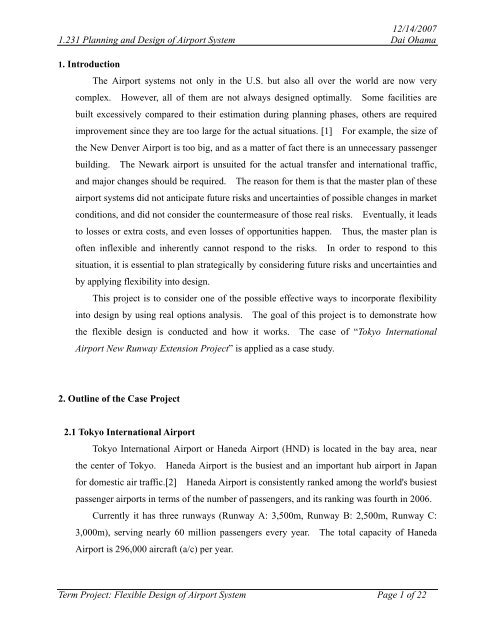Flexible Design of Airport System Using Real Options Analysis - MIT
Flexible Design of Airport System Using Real Options Analysis - MIT
Flexible Design of Airport System Using Real Options Analysis - MIT
You also want an ePaper? Increase the reach of your titles
YUMPU automatically turns print PDFs into web optimized ePapers that Google loves.
12/14/2007<br />
1.231 Planning and <strong>Design</strong> <strong>of</strong> <strong>Airport</strong> <strong>System</strong> Dai Ohama<br />
1. Introduction<br />
The <strong>Airport</strong> systems not only in the U.S. but also all over the world are now very<br />
complex. However, all <strong>of</strong> them are not always designed optimally. Some facilities are<br />
built excessively compared to their estimation during planning phases, others are required<br />
improvement since they are too large for the actual situations. [1] For example, the size <strong>of</strong><br />
the New Denver <strong>Airport</strong> is too big, and as a matter <strong>of</strong> fact there is an unnecessary passenger<br />
building. The Newark airport is unsuited for the actual transfer and international traffic,<br />
and major changes should be required. The reason for them is that the master plan <strong>of</strong> these<br />
airport systems did not anticipate future risks and uncertainties <strong>of</strong> possible changes in market<br />
conditions, and did not consider the countermeasure <strong>of</strong> those real risks. Eventually, it leads<br />
to losses or extra costs, and even losses <strong>of</strong> opportunities happen. Thus, the master plan is<br />
<strong>of</strong>ten inflexible and inherently cannot respond to the risks. In order to respond to this<br />
situation, it is essential to plan strategically by considering future risks and uncertainties and<br />
by applying flexibility into design.<br />
This project is to consider one <strong>of</strong> the possible effective ways to incorporate flexibility<br />
into design by using real options analysis. The goal <strong>of</strong> this project is to demonstrate how<br />
the flexible design is conducted and how it works. The case <strong>of</strong> “Tokyo International<br />
<strong>Airport</strong> New Runway Extension Project” is applied as a case study.<br />
2. Outline <strong>of</strong> the Case Project<br />
2.1 Tokyo International <strong>Airport</strong><br />
Tokyo International <strong>Airport</strong> or Haneda <strong>Airport</strong> (HND) is located in the bay area, near<br />
the center <strong>of</strong> Tokyo. Haneda <strong>Airport</strong> is the busiest and an important hub airport in Japan<br />
for domestic air traffic.[2] Haneda <strong>Airport</strong> is consistently ranked among the world's busiest<br />
passenger airports in terms <strong>of</strong> the number <strong>of</strong> passengers, and its ranking was fourth in 2006.<br />
Currently it has three runways (Runway A: 3,500m, Runway B: 2,500m, Runway C:<br />
3,000m), serving nearly 60 million passengers every year. The total capacity <strong>of</strong> Haneda<br />
<strong>Airport</strong> is 296,000 aircraft (a/c) per year.<br />
Term Project: <strong>Flexible</strong> <strong>Design</strong> <strong>of</strong> <strong>Airport</strong> <strong>System</strong> Page 1 <strong>of</strong> 22

















